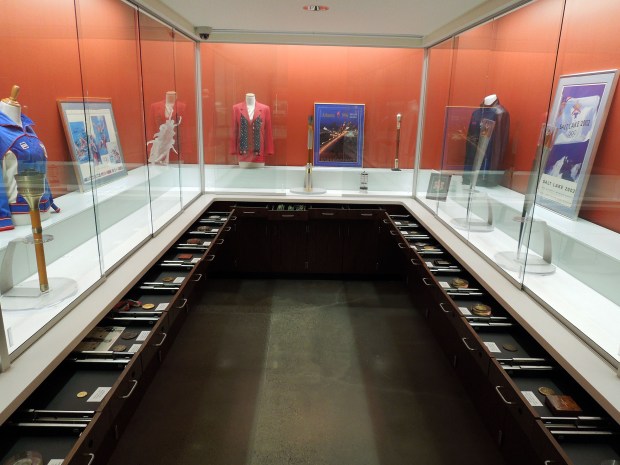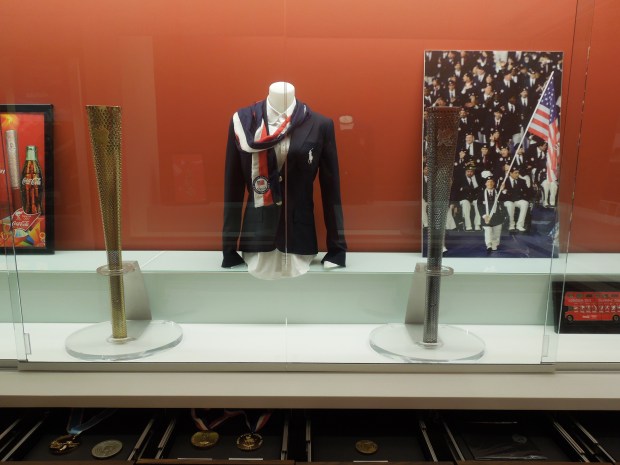This is the third post in our new There’s an Archivist for That! series, which will feature examples of archivists working in places you might not expect. To continue this new series, COPA member Rachel Seale, Outreach Archivist at Iowa State University, brings you an interview with Teresa Hedgpeth, archivist and historical steward for the Crawford Family U.S. Olympic Archives.

Teresa Hedgpeth (photograph courtesy of U.S. Olympic committee).
Teresa Hedgpeth was named as Archivist and Historical Steward for the Crawford Family U.S. Olympic Archives in July 2012. She is a professionally trained Certified Archivist with experience from the National Archives, the U.S. Naval Historical Center, U.S. Navy History & Heritage Command and the Western History Center.
For years the Olympic archives sat idle, stored in boxes in the basement of the shooting building at the Colorado Springs Olympic Training Center (CSOTC). Shortly after Teri came to the United States Olympic Committee (USOC), a meeting was arranged with donor, U.S. Olympic and Paralympic Foundation Board Chair and Olympic artifact collector, Gordon “Gordy” Crawford. Crawford began collecting Olympic memorabilia back in 1984 and is now the proud curator of one of the largest known collections.
As a result of that visit, Crawford pledged the funds to build a state-of-the-art archives to properly preserve and display the Olympic artifacts and archives. $1.5 million and 2 years later – along with thousands of hours of labor and Teri’s passion for preserving the Olympic movement in a way that all could benefit – the archives moved from the CSOTC to its new facility at the USOC headquarters and are available for private tours upon request .
The most common, and most feared, question Teri faces in her position is: What is your favorite artifact? Her emphatic response? “There is no answer to that question!”
Teri earned a Master of Arts degree in U.S. History from American University, Washington, DC; a Bachelor’s degree in History from Auburn University at Montgomery; attended the Civil War Institute; and, is a graduate of The National Archives’ Modern Archives Institute. She is a member of the American Association for State and Local History, the Society of American Archivists, and the International Society of Olympic Historians.
RS: How did you get your gig?
TH: I’ve always been a huge fan of the Olympic Games – I mean, who isn’t right? And, my daughters lived in Colorado Springs, where I was before taking the post as the archivist for the Western History Center in Casper, Wyoming; therefore, in 2012 when I saw the job posting for an archivist for the U.S. Olympic Committee, I jumped at the chance to prove to them I was the best candidate. It was a multi-step process of application, telephone interview, all-day on site interview and then I had to create a 5-year plan once the field was narrowed down. I am happy to say that the powers that be chose me to be the first archivist for the USOC.
RS: Tell us about your organization.
TH: The United States Olympic Committee is one of the most recognized non-profits in the world with a mission to support U.S. Olympic and Paralympic athletes in achieving sustained competitive excellence while demonstrating the values of the Olympic Movement, thereby inspiring all Americans. Founded in 1894 and headquartered in Colorado Springs, Colo., the USOC serves as both the National Olympic Committee and National Paralympic Committee for the United States. As such, the USOC is responsible for the training, entering and funding of U.S. teams for the Olympic, Paralympic, Youth Olympic, Pan American and Parapan American Games, while serving as a steward of the Olympic Movement throughout the country. In addition to its international Games responsibilities and its work to advance the Olympic Movement, the USOC aids America’s Olympic and Paralympic athletes through their National Governing Bodies, providing financial support and jointly working to develop customized, creative and impactful athlete-support and coaching education programs.
The United States Olympic Committee is governed by a 16-member board of directors and a professional staff headed by a CEO. The USOC also has three constituent councils to serve as sources of opinion and advice to the board and USOC staff, including the Athletes’ Advisory Council, National Governing Bodies Council and Multi-Sport Organizations Council. The mission of the USOC archives is to capture and preserve the history of the Olympic and Paralympic movements in the United States.
RS: Describe your collections.
TH: The USOC archives has numerous collections consisting of manuscript, photographic, three-dimensional and a sport library. Our manuscript records include the official history of the USOC as well as personal collections and records of the Olympic and Paralympic movements. The photograph collection consists of headshots and action shots of our athletes, coaches, staff and venues of Olympic, Paralympic, Pan American and ParaPan Games. We have not counted the images but we know the collection houses tens of thousands of images. Our photograph collection is probably the most visible aspect as it is used by our organization and accessed by news media and researchers.
Finally, the coolest part of our collection is the artifact collection. In this collection, we have Olympic and Paralympic uniforms, medals, and torches as well as additional ephemera associated with the Games such as pins, patches, stamps, tickets, merchandise, coins, cereal boxes, cabbage patch kids … you get the picture. Think of any company that is an Olympic sponsor and we most likely have a sample of what was created.

Special Collections (photograph courtesy of U.S. Olympic Committee).

Close-up view of Special Collections (photograph courtesy of U.S. Olympic Committee).
RS: What are some challenges unique to your collections?
TH: The biggest challenge for me involves completing our collections of U.S. Olympic and Paralympic uniforms, medals, torches, etc. The USOC did not start collecting artifacts until the 1980s and then it was only to support a traveling exhibit sponsored by Coca-Cola. There was no comprehensive collection policy in place. From that first call-out for memorablia, the collection grew to over 3,700 items when I started in 2012. Today, we have over 9,000 items and are continuing to fill in the gaps in our collection.
Another challenge is associated with our Olympic marks, the use of them and educating the public on how important it is to safeguard those. Unlike most National Olympic Committees around the world, the USOC doesn’t receive government funding to support athlete programs. The USOC is responsible for overseeing amateur athletics in the United States and for training, funding and sending Team USA to the Olympic and Paralympic Games every two years. To allow the USOC to fulfill these responsibilities, Congress granted the USOC broad rights to control commercial uses of USOC IP in the United States. Official corporate partners provide critical funding for elite athletes and athlete programs. The USOC allows our official partners to use USOC trademarks in recognition of their support for these athletes. When others use USOC IP without authorization, it creates a disincentive for our partners to continue funding Team USA in exchange for the right to promote that association with the U.S. Olympic Team.
And finally, I think the biggest challenge I face with our collection is convincing Olympians and Paralympians about the importance of safeguarding their history. Some athletes get this; but others think that since they did not medal, their history is not important. I am flabbergasted each time I run into this line of thought. They are the best of the best, chosen to represent our country in the most iconic world competitions and they think they are not important because they did not win a medal? When you take into consideration how few athletes win medals at the Games, this reasoning boggles my mind. In my opinion, yes, winning an Olympic or Paralympic medal is the ultimate achievement for these athletes; but, one cannot ignore the huge sacrifices each athlete, who made the Olympic or Paralympic team, endured just to be on that team. That’s what I love; all of what transpired before to get them to that point and that’s what I try to relate to them when I have the opportunity to talk to our athletes.
RS: What is the favorite part of your job?
TH: My favorite part? Oh man! I love researching our athletes and the items we receive. For example, a competition uniform is created for us by designers for use by our athletes. It is important that we know the designer and I love researching that history. Then, the uniform issued is worn by a specific athlete and I love finding out all about that athlete; what motivated them, what challenges they faced and how well they did, or did not do in competition. Sometimes the stories amaze you; they will inspire you and uplift you. Such as, Wilma Rudolph, who was born premature, contracted polio, wore leg braces until the age of 11; and then, just 5 years later competed in her first Olympic Games, at Melbourne in 1956 winning a bronze medal. But, four years later, at the age of 20, became the first U.S. female athlete to win 3 gold medals in a single Games.
Another aspect I love about my job is sharing these stories with others. We create historic displays and exhibits of our collection for use by our organization at events; we also conduct tours of our archives for different departments in our organization. Development, Marketing, International Relations all love to give their visitors a tour of the archives. Since we are not open to the public, this is a very special treat.
I am always asked, what is your favorite item in the archives or what is your favorite Olympic moment? One of my favorite Olympic moments revolves around the men’s 10,000-meters at the 1964 Tokyo Olympic Games. No one thought Billy Mills of the United States had a chance, except him; he knew he could do it. I love watching the video of that race. Listen to the announcers, one even stated, “Billy Mills from the United States is in there, a man no one expects to win this particular event.” In the final lap, Ron Clarke of Australia elbows Mills out of the lead. No sooner is that done when Mohamad Gammoudi of Tunisia pushes through them both and takes over. Mills is third and it seems out of the race after being jostled by both front runners. However, in the final 100 yards, Mills comes on the outside of both runners in a blazing burst of speed to win, becoming the first American to win the 10,000-meter race. Wow! Chills every time I see that! That is one athlete I would love to have in our collection.
Stay tuned for future posts in the “There’s an Archivist for That!” series, featuring stories on archivists working in places you might not expect. If you know of an archivist who fits this description or are yourself an archivist who fits this description, the editors would love to hear from you—share in the comments below or contact archivesaware@archivists.org to be interviewed on ArchivesAWARE!


